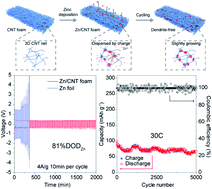3D confined zinc plating/stripping with high discharge depth and excellent high-rate reversibility†
Abstract
Aqueous Zn-based batteries have been considered as a promising energy storage device due to their high safety, low cost, nontoxicity, and high energy density. However, the poor cycle life-span and limited utilization of zinc anodes due to dendrite growth restrict the practical application of such batteries. Herein, we report the preparation of a Zn/carbon nanotube (Zn/CNT) foam, where zinc plating/stripping is confined in a robust 3D interconnected CNT network. When tested in symmetric cells, the Zn/CNT foam shows excellent cycling stability at high depth of discharge (DODZn, e.g. 100% capacity retention at DODZn < 81% after hundreds of cycles) and high current densities with low overpotentials and without dendrite formation, outperforming zinc foils. As a result, aqueous Zn//MnO2 batteries assembled using Zn/CNT foam as the anode exhibit high-rate and long-term cycling performance, resulting in a high energy density of 169 W h kg−1 (1C) and a high power density of 3.1 kW kg−1 (30C). This 3D confinement strategy for zinc plating and stripping could help the development of high-energy-density and high-power density zinc-based batteries.



 Please wait while we load your content...
Please wait while we load your content...